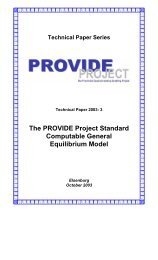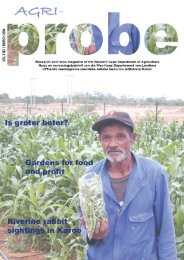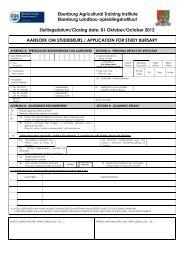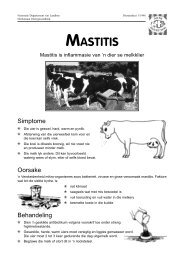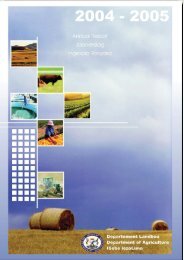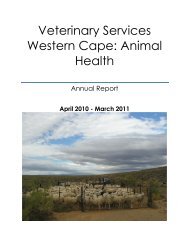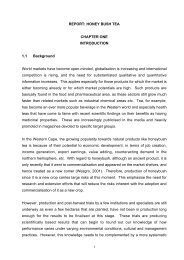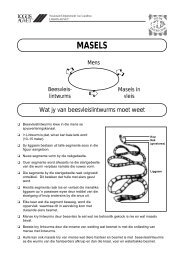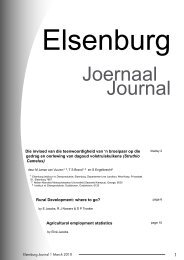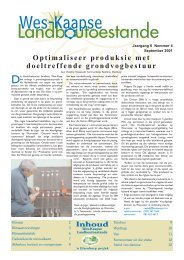Download Elsenburg Joernaal/Journal - Department of Agriculture ...
Download Elsenburg Joernaal/Journal - Department of Agriculture ...
Download Elsenburg Joernaal/Journal - Department of Agriculture ...
Create successful ePaper yourself
Turn your PDF publications into a flip-book with our unique Google optimized e-Paper software.
2003. Seasonal employment increased considerably (from<br />
26 000 to 39 000 workers) which might indicate that workers<br />
moved from permanent and temporary employment towards<br />
seasonal employment. This is more visible in the 2006 and<br />
2007 data, where permanent and seasonal employment is<br />
mirror images <strong>of</strong> each other. Investigating the employment<br />
figures with regards to race, the following pattern occurs:<br />
Above figure indicates that employment within the agricultural<br />
sector decreased steadily since 2000, but this was<br />
due to mainly Coloured workers leaving the sector. Quantec<br />
(Consultancy) total employment data were compared<br />
to Labour Force data, and a similar trend is recognized.<br />
Taking into consideration both figures, seasonal employment<br />
increased in spite <strong>of</strong> overall decreases in employment.<br />
There is thus evidence that some <strong>of</strong> the permanent worker<br />
decrease is accounted for by the seasonal worker increase,<br />
but the overall decrease suggests that more workers leave<br />
the agricultural sector than workers joining it. The increase<br />
in seasonal workers might be explained by workers without<br />
any other means <strong>of</strong> income, and therefore accepting the<br />
terms <strong>of</strong> the seasonal employment standards. One thing is<br />
for sure: Seasonal workers increased and permanent workers<br />
decreased, creating the current opportunities for labour<br />
contractor involvement.<br />
Labour Contractors<br />
According to Wikipedia (online), a contractor is an agent,<br />
“one that acts on behalf <strong>of</strong> a principal”. In <strong>Agriculture</strong>, a<br />
labour contractor is the mediator between farmer and<br />
farm worker. The farmer does not want to employ permanent<br />
workers, for various reasons, and uses contractors<br />
to provide them with workers if need be. Contractors in<br />
turn employ workers to work on farms where they as<br />
contractors get work contracts. This seems like an ideal<br />
situation, farmers benefit from attaining workers to fulfil<br />
their requirements, and farm workers can live where they<br />
want to, and work on different farms. Farm workers therefore<br />
can get all the amenities <strong>of</strong> living in the urban areas,<br />
but still work on farms.<br />
But labour contractors are unregulated in most <strong>of</strong> South<br />
Africa, and not covered in the legal framework 1 . Due to<br />
this unregulated design, data for labour contractors and<br />
labour contractor involvement is limited. Two case studies<br />
were done from 2006 to investigate the casualisation <strong>of</strong><br />
workers and labour contractor’s participation in the process.<br />
The first study was conducted by Conradie in 2006 at the Hex<br />
River Valley grape farms. Casualisation, as part as employment<br />
trends, were analysed and results included that the reallocation<br />
<strong>of</strong> permanent workers to seasonal workers in other fruit farms<br />
were not visible in the case study. There was a steady decline in<br />
employment, but this was due to technological change and not<br />
legislative changes relating to land and labour. The composition<br />
<strong>of</strong> the workforce also did not change dramatically. Concluding<br />
from the case study is that legalisation is not always the cause<br />
<strong>of</strong> casualisation, but it may contribute towards the process.<br />
The Extension <strong>of</strong> Security <strong>of</strong> Tenure Act (Act 62 <strong>of</strong> 1997) is an<br />
example <strong>of</strong> such contribution from legislation. More reliable<br />
data is also needed for measuring casualisation. Data collection<br />
needs to be sensitive to the irregular work conditions <strong>of</strong> <strong>of</strong>f-farm<br />
seasonal workers in order to record consistent employment patterns.<br />
The question <strong>of</strong> the employment strategy from the farmer<br />
remains puzzling and it seems that it depends on the farmer’s<br />
perception <strong>of</strong> the economic state <strong>of</strong> affairs and authoritarian<br />
environment.<br />
The second case study was conducted by the Centre<br />
for Legal Rural Studies and Women on Farms Project in the<br />
Grabouw area between November 2007 and February 2008.<br />
Findings concluded that seasonal workers and permanent work-<br />
1 See next section for detailed discussion<br />
<strong>Elsenburg</strong> <strong>Joernaal</strong><br />
2008 (2)<br />
Number <strong>of</strong> Workers<br />
300,000<br />
250,000<br />
200,000<br />
150,000<br />
100,000<br />
50,000<br />
0<br />
Figure 1: Work Status <strong>of</strong> the Western Cape Agricultural Workforce<br />
from 2000 till 2007 Source: Own Calculations out <strong>of</strong><br />
Labour Force Survey’s 2000-2007<br />
Employment figures for Western Cape Agricultural Workforce<br />
2000 2001 2002 2003 2004 2005 2006 2007<br />
Total<br />
Quantec<br />
African/Black<br />
Coloured<br />
White<br />
Figure 2: Employment data for Western Cape Agricultural<br />
Workforce from 2000 till 2007 Source: Own Calculation from<br />
Labour Force Survey’s 2000-2007 and Quantec Data (2008)<br />
ers do not receive the same benefits; only permanent workers<br />
are likely to receive benefits; transportation and accommodation<br />
<strong>of</strong> seasonal workers are troublesome; there is no clarity <strong>of</strong> who<br />
the employer is, some say the farmer, others say the contractor;<br />
seasonal workers are not registered for Unemployment<br />
Insurance or Workmen’s compensation or belong to a union;<br />
and some element <strong>of</strong> child labour was detected. Workers were<br />
paid under the minimum wage and only work certain days, the<br />
principle <strong>of</strong> no work no pay applies. They are also paid by performance,<br />
which mean the physically stronger or more efficient<br />
worker get paid more, making it difficult for women to ensure<br />
a better income. Migrant workers dominate (64% were from<br />
Transkei) because the contracts <strong>of</strong>fered by the building sector<br />
provides better pay to local workers. 75% <strong>of</strong> labour contractors<br />
also do not have any knowledge <strong>of</strong> the labour law <strong>of</strong> South Africa<br />
and they work from their homes. Their conclusions from the<br />
case study is that casualisation gives rise to the employment<br />
figures <strong>of</strong> seasonal and migrant workers which in turn creates<br />
an unstable and unfair labour market where the legal framework<br />
<strong>of</strong> South Africa have no reach.<br />
These two case studies indicate that casualisation is on the<br />
rise, and labour contractors are using the opportunity presented<br />
to them. Because <strong>of</strong> the unregulated environment, farm workers<br />
6



